
All categories
Featured selections
Trade Assurance
Buyer Central
Help Center
Get the app
Become a supplier

(4580 products available)







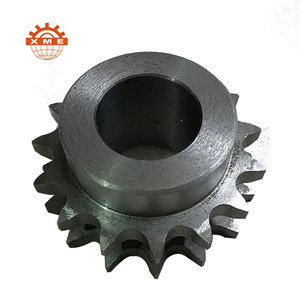
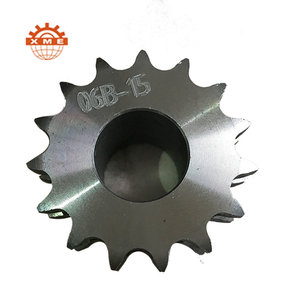





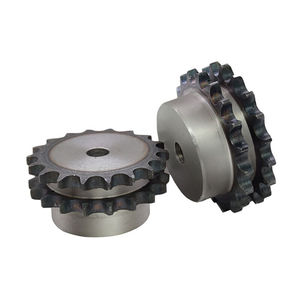
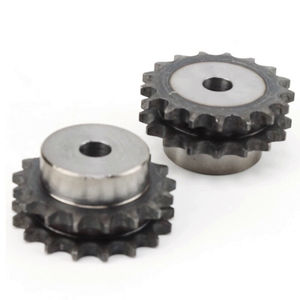
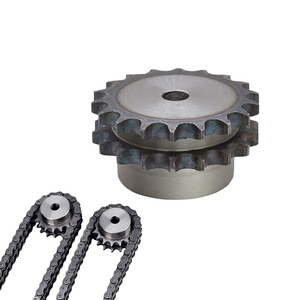






















Sprockets with bearings are categorized according to the drive chain, pitch, construction material, number of teeth, and the kind of bearing integrated into the sprocket. The following section presents these differences in detail.
These are the most common types. Chain sprockets are designed to work with roller chains in power transmission systems. The sprocket teeth have a specific shape to fit securely with the chain links, ensuring efficient torque transfer.
Sometimes referred to as sheaves or pulleys, belt sprockets are used in belts for power transmission systems. These sprockets do not have teeth; instead, they have grooves or flat surfaces where belts sit. Greater distances than chain drives can be handled by belt drives with a sprocket.
Pin sprockets are used in pin chains, another type of power transmission chain. A pin chain consists of a series of connected metal rods or pins, and the pin sprocket teeth have holes that accommodate the pins. These sprockets handle heavier loads and are often employed in specialized industrial applications.
Angular sprockets, also known as curved or conical sprockets, are designed to transmit power at an angle between two shafts. These sprockets are used in applications where the drive and driven components are not aligned, enabling the transmission system to function effectively even at an angle.
Sprockets are designed for specific applications or industries. For Example, for high-load conditions, oversized or high-teeth-count sprockets, and aftermarket replacements for maintenance purposes. For reducing and increasing gear ratios, lector and idler sprockets are used.
Also known as a hole or centerless sprockets, these components are utilized when a shaft or other element must pass through the center of the sprocket and are fixed directly to the rotating shaft. Such sprockets are featured in compact designs where space is limited.
These, too, are commonly referred to as wheel sprockets. They are fitted on vehicles with wheels or tracks, such as skateboards, motorcycles, chain saws, and heavy machinery. Castor sprockets provide smooth movement and durable construction for the long-term outdoor application.
Durability is an important consideration when choosing a sprocket with bearing because it has to endure constant motion, heavy loads, and environmental factors. The longevity of these components is primarily determined by the materials used in their making, the choice of bearings, and how the assembly is constructed and maintained.
This material is generally considered the strongest and most commonly used for making sprockets owing to its excellent strength and wear resistance. Large industrial machinery employs alloy steel sprockets because of its durability, which is required for heavy-duty applications. They are, therefore, highly resistant to deformation, which occurs under heavy loads and frequent use. This is because of their hardness. Alloy steel bearings are often treated, increasing the sprocket's hardness and wear resistance.
This is a variety of steel manufactured through heat or surface treatment. This treatment leads to increased hardness and wear resistance. These types of chain saw parts and sprockets are ideal for high-performance applications, such as machinery. For similar reasons, they also resist deformation and wear. Therefore, they are especially effective in applications involving extreme loads and contact.
This is an alloy steel variation aimed at improving resistance to corrosive elements such as water and chemicals. Used in environments with high humidity or where chemical exposure is possible, stainless steel sprockets increase durability. These types of sprockets are found in food processing, marine, and chemical industries. While stainless steel provides corrosion resistance, it may not be as wear-resistant as hardened or alloyed steel.
Plastic sprockets, such as those made of polymer, are ideal for lightweight applications. Some of these applications include those with less torque, electrical equipment, and precision machinery. These materials reduce friction and come in handy in such applications. The absence of friction causes less wear on the sprocket and chain. Although less robust than metal variants, they serve as a more affordable option for low-stress applications to ensure extended functionality.
Aluminium alloy sprockets have been identified as lighter than steel, making them ideal for applications where weight matters, such as in bicycles or aerospace components. These alloys balance strength and weight; therefore, they offer reasonable strength and improved resistance to corrosion. Additional features include cut or hollowed designs that reduce unnecessary weight while maintaining the structure's integrity and strength.
Chromium plating increases the surface hardness of a sprocket, reducing wear and increasing durability. Chrome plating is commonly found on high-wear components, including those used in motors and tools. The chrome layer inhibits rust formation, which is beneficial for outdoor or humid activities. It assists in providing a smooth surface that lowers friction and minimizes wear on companion components.
In extreme environments, high-performance alloys, including titanium and nickel-based superalloys, are necessary for aerospace and heavy industries. These materials are very resistant to wear, fatigue, and corrosion. These materials are especially useful for high-temperature applications, during which conventional materials might weaken or succumb to wear. Superior strength-to-weight ratios make them well-suited for applications where performance in the air is critical.
Sprockets are found in multiple industries, performing power transmission functions in mechanical systems. The following examples show how versatile the s-procket with bearings is for different commercial applications.
Heavy machinery, including manufacturing plants and construction sites, employs sprockets heavily. Here, they facilitate the transmission of chains under great weight, which results in moving large items. Durable sprockets are a must in these venues. They have to endure enormous pressure and frequent use. That is why large machinery turns to heavy-duty alloy steel or hardened sprockets. In industrial equipment, maintenance must also be taken into account. There are high costs involved when production systems suffer from downtime. Wear-resistant sprockets are preferable because they improve durability and decrease the likelihood that the system will fail.
Bicycles, motorcycles, and vehicles also rely on chain drives for power transfer. In these settings, sprockets coordinate the transmission of motion and torque from the engine to the wheels. A reliable and effective performance is needed for automotive applications. Cars, for example, should have lightweight but strong aluminium or stainless steel sprockets. These ensure that there is an optimal balance between strength and corrosion resistance. In the case of transportation, because of the long distances, the focus is on low maintenance. Sealed bearings inside the sprocket assemblies are needed to reduce lubrication checks and provide longer life.
Sprockets are used in conveyor systems and material handling equipment to move objects. Basically, they drive the conveyor chains that transport materials, products, and equipment. Durable and reliable sprockets provide unrestricted and timely movement in warehouses and industrial plants. Chain driven roller and flat belt conveyors commonly use sprockets to drive them. They power heavy loads within the warehouse and sort transportation systems in industrial units.
Livestock feed, irrigation pumps, and tillage equipment all have sprockets. They are used to provide power transmission throughout farming equipment in the agricultural industry. But in most cases, the loads are quite large, and the operating conditions are extremely difficult. Thus, sprockets utilized in agricultural machinery need to be extremely durable. They should be of the highest quality and made from materials that are extremely resistant to wear. These include heavy-duty alloys, hardened steel, and high-performance composites, which are used in the farming machines.
Extreme operating conditions are the norm in mining and heavy industries. Sprockets in these environments must carry large loads, resist extreme debris exposure, and have a long wear life. These are high-performance steel sprockets with special treatments to withstand abrasion.
Buyers have to consider multiple factors when selecting the right sprocket with bearings. Some key factors to consider include the application, chain pitch, number of teeth, load-carrying capacity, materials used, bearing type, operating environment, diameter, maintenance requirements, and cost.
Sprockets are often used for power transmission in machines, bicycles, and conveyors. These various applications might require different types of sprockets, varying in size, tooth number, and material complexity. Heavy industries use durable CSN, while bicycles can use lighter Alu. Know the intended end use and operating conditions for better selection.
The distance between two adjacent rivets on the chain determines the chain pitch. The sprocket must fit correctly at this pitch to ensure smooth engagement. Buyers should use the existing chain's pitch when selecting a new sprocket for replacement. New systems also need sprockets with the same pitch as their planned chain.
The required adjustment or reduction in the gear will mean the right number of teeth. Larger ones provide more power and torque with slower speeds. Small ones mean faster rotation with less force. Buyers should take the application requirements into account when determining the optimal number of teeth.
Ensure the sprocket can handle the system's total load. This includes the load from the motor and any external force. Using longer-life materials for the bearing and transport will reduce wear and extend usage.
Metal and polymer materials are commonly used in making sprocket and bearing systems. Metals like stainless steel are corrosion-resistant and wear-resistant. Plastics, on the other hand, are cheaper, weigh less, and have friction-reducing abilities. However, they might not possess the required strength. That is why they are used in applications with less torque. For high-torque applications, alloy or hardened steel bearings are preferred.
Sprockets feature different types of bearings integrated into them. There are radial, angular, thrust, and composite bearings, each serving a different purpose. For example, radial ball bearings are commonly used in low-load applications, while angular contact bearings are suitable for high-load, high-axial-force applications.
Bearing lubrication occurs in various environments; dust, chemicals, and extreme temperatures may affect the choice. For example, chemical exposure will demand a corrosion-resistant material like stainless steel. Dusty environments will need seals to prevent debris from entering. High-temperature environments might require different lubricants with a higher temperature threshold.
Maintenance is sometimes a consideration, especially in hard-to-reach areas. Certain sprocket and bearing combinations have sealed or greased lubricated bearings that reduce maintenance needs. This setup is great in applications where frequent maintenance is impractical. Buyers should consider the maintenance needs that fit well with their operational capabilities.
A1. A sprocket with bearing is a toothed wheel or pully integrated with one or more types of bearings for use in belt and chain drives. The bearing reduces friction by enabling smoother rotation of the sprocket around its central shaft. It improves energy transmission efficiency and increases the system's load-carrying capability.
A2. Both are power transmission components, but their designs and applications differ. Sprockets have teeth; hence, they engage with chain for transmission. Conversely, pulleys are smooth; they work with belts. Sprockets are more suitable for heavy-duty applications due to the better grip of the teeth in high-torque situations.
A3. Sealed bearings contain lubricants within, protecting the lubricant from external contaminants like dust and debris. Since sealed bearings do not need frequent lubrication, they reduce maintenance and installation concerns. Additionally, the sealed bearing's longer lifespan increases the overall reliability of the sprocket system.
A4. Buyers should keep operating within the load limit, using the proper lubricant, and keeping the system clean. They should regularly inspect for wear, misalignment, and adjustments or tensioning as needed.
A5. This setup includes equipment like conveyor belts used in material handling and transporting goods. Chain saws used for cutting and pruning in forestry and agriculture, skate wheels used in robotics for movement and balance, and even heavy machinery like excavators and dozers with track systems.